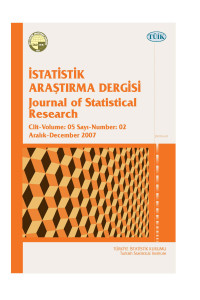Research Article
A Review on the Ridit Analysis
Abstract
Appropriate methods for analysis of ordinal data, though familiar to statisticians are less well known to practicing scientists and clinicians. Consequently, treatment of ordinal data has been inconsistent, with some investigators analyzing ordinal ratings as if they were true quantitative measurements yielding means and standard errors and others treating similar data as purely nominal categories, ignoring even the ordered nature of the responses. Ridit Analysis is a statistical method for comparing ordinal-scale responses. It was introduced by Bross as a means of comparing ordinal scale responses such as degree of injury, dissatisfaction, preference or agreement. Since then, his technique has found application in such fields as epidemiology, questionnaire design, biomedicine and psychology. The Ridit score does not require a normal distribution and preserves differences present in the (ordinal) data. It can be applied to nominal, interval and ratio data as well. The aim of this study is to introduce this method to the researchers. For this aim a simulated data was used.
Keywords
References
- Beder, J. H. And Heim, R. C., 1990. On the use of Ridit Analysis. Psychometrika, 55 (4). 603-616.
- Brockett, P. L. And Levine, A., 1977. On a characterization of Ridits. The Annals of Statistics, 5 (6), 1245-1248.
- Bross, I. D. J., 1958. How to use Ridit Analysis. Biometrics, 14: 18-38.
- Donaldson, G. W., 1988. Ridit scores for analysis and interpretation of ordinal pain data. European Journal of Pain, 221-227.
- Doyle, M. And Dorling, S., 2002. Visibility trends in the UK 1950-1997. Atmospheric Environment, 36, 3161-3172.
- Fleiss, J.L., Chilton, N. W., Wallenstain, S., 1979. Ridit Analysis in dental clinical studies. J. Dent. Res., 58 (11), 2080-2084.
- Flora, J. D., 1974. A note on Ridit Analysis. Technical Report, Michigan.
- Goossen, W. T. F., 2001. Exploiting the nursing minimum data set for the Netherlands. Medinfo, 1334-1338.
- Lewis, J. and Baldwin, J., 1997. Ridit Analysis. Statistical Package for Improved Analysis of Hillslope Monitoring Data Collected as Part of the Board of Forestry's Long-Term Monitoring Program.
- Norman, M. B., 1969. The structure of the psychological well-being. Aldine Pub. Co., Chicago, 249-256.
- Pouplard, N., Qannari, E. M., Simon, S., 1997. Use of Ridits to analyse categorical data in preference studies. Food Quality and Preference, 8 (5-6), 419-42
Ridit Analizi
Abstract
Sıralı ölçek ile ölçülmüş verilerin analizi için uygun olan metotlar, istatistikçiler tarafından bilinmesine rağmen klinisyen ve uygulama ile uğraşan bilim adamları tarafından daha az bilinen metotlardır. Dolayısıyla, sıralı verilerin sıralı yapısının göz ardı edilerek, bazı araştırmacıların yaptığı gibi ortalama ve standart hataların hesaplanabildiği kantitatif ölçümler veya nominal kategoriler gibi analiz edilmesi uygun değildir. Ridit Analizi, sıralı ölçek ile elde edilen cevapların karşılaştırılmaları için geliştirilmiş bir istatistiksel metottur. Yöntem, Bross tarafından yaralanma, tatminsizlik, tercih veya hem fikir olma düzeyleri gibi sıralı ölçekli cevapların karşılaştırılması anlamında literatüre kazandırılmıştır. Yöntem ortaya atılmasından sonra epidemiyoloji, anket düzenleme, tıbbi tedavi ve psikoloji gibi alanlarda da kullanılmıştır. Ridit değerleri normal dağılıma ihtiyaç duymaz ve sıralı verilerde mevcut olan farklılıkları belirler. Yöntem bilinen hali ile sınıflayıcı, aralıklı ve oranlı ölçek kullanılarak elde edilen verilere de uygulanabilmektedir. Bu çalışmanın amacı, araştırmacılara yöntemi tanıtmaktır. Çalışmada simülatif olarak türetilmiş veriler kullanılmıştır.
Keywords
References
- Beder, J. H. And Heim, R. C., 1990. On the use of Ridit Analysis. Psychometrika, 55 (4). 603-616.
- Brockett, P. L. And Levine, A., 1977. On a characterization of Ridits. The Annals of Statistics, 5 (6), 1245-1248.
- Bross, I. D. J., 1958. How to use Ridit Analysis. Biometrics, 14: 18-38.
- Donaldson, G. W., 1988. Ridit scores for analysis and interpretation of ordinal pain data. European Journal of Pain, 221-227.
- Doyle, M. And Dorling, S., 2002. Visibility trends in the UK 1950-1997. Atmospheric Environment, 36, 3161-3172.
- Fleiss, J.L., Chilton, N. W., Wallenstain, S., 1979. Ridit Analysis in dental clinical studies. J. Dent. Res., 58 (11), 2080-2084.
- Flora, J. D., 1974. A note on Ridit Analysis. Technical Report, Michigan.
- Goossen, W. T. F., 2001. Exploiting the nursing minimum data set for the Netherlands. Medinfo, 1334-1338.
- Lewis, J. and Baldwin, J., 1997. Ridit Analysis. Statistical Package for Improved Analysis of Hillslope Monitoring Data Collected as Part of the Board of Forestry's Long-Term Monitoring Program.
- Norman, M. B., 1969. The structure of the psychological well-being. Aldine Pub. Co., Chicago, 249-256.
- Pouplard, N., Qannari, E. M., Simon, S., 1997. Use of Ridits to analyse categorical data in preference studies. Food Quality and Preference, 8 (5-6), 419-42
There are 11 citations in total.
Details
| Primary Language | English |
|---|---|
| Subjects | Statistics |
| Journal Section | Research Articles |
| Authors | |
| Publication Date | December 14, 2007 |
| Published in Issue | Year 2007 Volume: 5 Issue: 2 |

